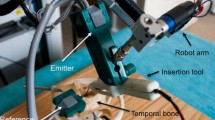Abstract
Purpose
The aim of this study was to create an access canal to the inner ear, by drilling, and perform the cochleostomy for cochlear implant surgery using robot guidance.
Methods
A robot, a surgical drill and an Image-Guided Surgery (IGS) system were combined in a closed-loop setup. Ten temporal bones were scanned at the planning stages of the procedure. The robot guided the drill along the preplanned trajectory and created the approach. Postoperative scans were obtained.
Results
The cochleostomy was performed completely in nine out of ten cases. This did not prove possible for one of the specimens, the target site selected being in too superficial a location in relation to the round window. No violation of the facial nerve took place, although the chorda tympani nerve was violated in one case and the stapes in two. It was obvious during preoperative planning that these structures would be violated, but this was accepted in order to maintain a safety margin from the facial nerve. No other unforeseen damage occurred.
Conclusions
This preliminary study suggests that robot-guided drilling of a minimally invasive approach to the cochlea might be feasible, but further improvements are necessary before any clinical application becomes possible. Where the width of the facial recess is less than 2.5 mm, the chorda tympani nerve and the ossicles are at risk.
Similar content being viewed by others
References
Adunka OF, Radeloff A, Gstoettner WK et al (2007) Scala tympani cochleostomy II: topography and histology. Laryngoscope 117: 2195–2200. doi:10.1097/MLG.0b013e3181453a53
Roland PS, Wright CG, Isaacson B (2007) Cochlear implant electrode insertion: the round window revisited. Laryngoscope 117: 1397–1402. doi:10.1097/MLG.0b013e318064e891
Schipper J, Klenzner T, Aschendorff A et al (2004) Navigiert-kontrollierte Kochleostomie. Ist eine Verbesserung der Ergebnisqualitat in der Kochleaimplantatchirurgie moglich? HNO 52:329–335 (Navigation-controlled cochleostomy. Is an improvement in the quality of results for cochlear implant surgery possible?) doi:10.1007/s00106-004-1057-5
Bhatia K, Gibbin KP, Nikolopoulos TP et al (2004) Surgical complications and their management in a series of 300 consecutive pediatric cochlear implantations. Otol Neurotol 25: 730–739. doi:10.1097/00129492-200409000-00015
Bielamowicz SA, Coker NJ, Jenkins HA et al (1988) Surgical dimensions of the facial recess in adults and children. Arch Otolaryngol Head Neck Surg 114: 534–537
Su WY, Marion MS, Hinojosa R et al (1982) Anatomical measurements of the cochlear aqueduct, round window membrane, round window niche, and facial recess. Laryngoscope 92: 483–486. doi:10.1288/00005537-198205000-00003
Teszler CB, Ruimi D, Bar-Meir E (2005) Width of the extended facial recess: a numerical study of ultrahigh-resolution computed tomography and its implications in minimally invasive otologic surgery. Otol Neurotol 26: 782–789. doi:10.1097/01.mao.0000178141.04601.dc
Klenzner T, Ngan CC, Knapp FB et al (2009) New strategies for high precision surgery of the temporal bone using a robotic approach for cochlear implantation. Eur Arch Otorhinolaryngol 266: 955–960. doi:10.1007/s00405-008-0825-3
Baron S, Eilers O, Hornung O et al (2006) Conception of a robot assisted cochleostomy: first experimental result. In: Proc of the 7th international workshop on research and education in mechatronics, REM2006, Stockholm
Brett PN, Taylor RP, Proops D et al (2007) A surgical robot for cochleostomy. Conf Proc IEEE Eng Med Biol Soc 2007: 1229–1232. doi:10.1109/IEMBS.2007.4352519
Kronenberg J, Migirov L, Dagan T (2001) Suprameatal approach: new surgical approach for cochlear implantation. J Laryngol Otol 115: 283–285. doi:10.1258/0022215011907451
Labadie RF, Chodhury P, Cetinkaya E et al (2005) Minimally invasive, image-guided, facial-recess approach to the middle ear: demonstration of the concept of percutaneous cochlear access in vitro. Otol Neurotol 26: 557–562. doi:10.1097/01.mao.0000178117.61537.5b
Labadie RF, Majdani O, Fitzpatrick JM (2007) Image-guided technique in neurotology. Otolaryngol Clin North Am 40:611–624. x. doi:10.1016/j.otc.2007.03.006
Labadie RF, Noble JH, Dawant BM et al (2008) Clinical validation of percutaneous cochlear implant surgery: initial report. Laryngoscope 118: 1031–1039. doi:10.1097/MLG.0b013e31816b309e
Leinung M, Baron S, Eilers H et al (2007) Robotic-guided minimally-invasive cochleostomy: first results. GMS CURAC;2(1):Doc05 (http://www.egms.de/pdf/journals/curac/2007-2/curac000021.pdf)
Majdani O, Bartling SH, Leinung M et al (2008) A true minimally invasive approach for cochlear implantation: high accuracy in cranial base navigation through flat-panel-based volume computed tomography. Otol Neurotol 29: 120–123. doi:10.1097/mao.0b013e318157f7d8
Majdani O, Bartling SH, Leinung M et al (2008) Navigationsgefuhrte minimal-invasive Cochlea-Implantation—Untersuchungen am humanen Felsenbein. Laryngorhinootologie 87:18–22 (Image-guided minimal-invasive cochlear implantation—experiments on cadavers). doi:10.1055/s-2007-966775
Bartling SH, Leinung M, Graute J et al (2007) Increase of accuracy in intraoperative navigation through high-resolution flat-panel volume computed tomography: experimental comparison with multislice computed tomography-based navigation. Otol Neurotol 28: 129–134. doi:10.1097/01.mao.0000244364.16826.09
Eilers H, Hussong A, Baron S et al (2007) Optimierung der trajektorienplanung für eine minimalinvasive cochleostomie (optimization of the target planning for minimally invasive cochleostomy). In: Proceedings of the 6th annual congress of the German society for computer- and robot assisted surgery(CURAC 2007). Karlsruhe, pp 219–222
Hussong A, Rau T, Eilers H (2008) Conception and design of an automated insertion tool for cochlear implants. In: Proc of the 30th annual international conference of the IEEE engineering in medicine and biology society. EMBC, Vancouver, pp 5593–5596
Fitzpatrick JM, Hill DLG, Maurer CR (2000) Image registration. In: Beutel J, Sonka M, Kundel HL, Fitzpatrick JM, Van Metter RL (eds) Handbook of medical imaging: medical image processing and analysis. SPIE Press 2000 (ISBN 0819436224, 9780819436221), pp 449–513
Cohen NL, Roland JT Jr, Fishman A (2002) Surgical technique for the nucleus contour cochlear implant. Ear Hear 23: 59S–66S. doi:10.1097/00003446-200202001-00007
Fitzpatrick JM, West JB, Maurer CR Jr (1998) Predicting error in rigid-body point-based registration. IEEE Trans Med Imaging 17: 694–702. doi:10.1109/42.736021
Labadie RF, Shah RJ, Harris SS et al (2004) Submillimetric target-registration error using a novel, non-invasive fiducial system (the EarMarkTM) for image-guided otologic surgery. Comput Aided Surg 9: 145–153. doi:10.1080/10929080500066922
Author information
Authors and Affiliations
Corresponding author
Additional information
Source of financial support or funding: Deutsche Forschungsgemeinschaft (DFG-German Research Foundation), Priority Program 1124 (Medical Robotics).
Rights and permissions
About this article
Cite this article
Majdani, O., Rau, T.S., Baron, S. et al. A robot-guided minimally invasive approach for cochlear implant surgery: preliminary results of a temporal bone study. Int J CARS 4, 475–486 (2009). https://doi.org/10.1007/s11548-009-0360-8
Received:
Accepted:
Published:
Issue Date:
DOI: https://doi.org/10.1007/s11548-009-0360-8




